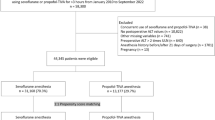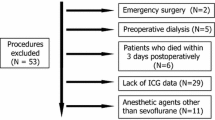Abstract
The incidence of post-anesthetic mild liver disorder (PAMLD) was compared between 928 patients administered halothane and 1,766 patients administered enflurane. They were selected from 19,504 surgical patients administered general anesthesia at Kyushu University Hospital over the past 6 years and 4 months. They had had normal liver function before operation and had no history of blood transfusion. Alanine aminotransferase (ALT) levels exceeding 70 IU·l −1 within 180 days after operation were found in 226 patients in the halothane group (24.4%), and in 250 patients in the enflurane group (14.2%) (P<0.01). Both maximum ALT levels and duration of ALT elevation were higher and longer in the halothane group (P<0.01). These results suggest that, not only in the development of fulminant hepatitis but also in PAMLD, enflurane is less hepatotoxic than halothane.
Similar content being viewed by others
References
1. Subcommittee on the National Halothane Study of the committee on Anesthesia National Academy of Science-National Research Council: Summary of the National Halothane Study. JAMA 197:775–778, 1966
Lewis JH, Zimmerman HJ, Ishak KJ, et al: Enflurane hepatotoxicity, A clinicopathologic study of 24 cases. Ann Internal Med 98:984–992, 1983
Inman WHW, Mushin WW: Jaundice after repeated exposure to halothane: An analysis of reports to the Committee on Safety of Medicines. Brit Med J 1:5–10, 1974
DeBacker LJ, Longnecker DS: Prospective and retrospective searches for liver necrosis following halothane anesthesia. JAMA 195:95–160, 1066
Mushin WW, Rosen M, Bowen DJ, et al: Halothane and liver dysfunction: a retrospective study. Brit med J 2:329–341, 1964
Böttiger LE, Dalén E, Hallén B: Halothane-induced liver damage: An analysis of the material reported to the Swedish Adverse Drug Reaction Committee, 1966–1973. Acta Anaesth Scand 20:40–46, 1976
Stock JGL, Strunin L: Unexplained hepatitis following halothane. [review article]. Anesthesiology 63:424–439, 1985
Brown MB: Two-way and multi-way frequency tables, BMDP Statistical Software. Edited by Dixon WJ. Berkeley, University California Press, 1985, pp. 143–206
Wright R, Eade OE, Chisholm M, et al: Controlled prospective study of the effect on liver function of multiple exposures to halothane. Lancet 12:817–820, 1975
Trowell J, Peto R, Smith AC: Controlled trial of repeated halothane anaesthetics in patients with carcinoma of the uterine cervix treated with radium. Lancet 12:821–823, 1975
Kalow B, Rogoman E, Sims FH: A comparison of the effects halothane and other anaesthetic agents on hepato-cellular function in patients submitted to elective operations. Canad Anaesth Soc J 23:71–79, 1976
McEwan J: Liver function tests following anaesthesia. Br J Anaesth 48:1065–1069, 1976
Cousins MJ, Plummer JL, Hall PM: Risk factors for halothane hepatitis. [review article]. Aust N Z J Surg 59:5–14, 1989
Allen PJ, Downing JW: A prospective study of hepatocellular function after repeated exposures to halothane or enflurane in women undergoing radium therapy for cervical cancer. Br J Anaesth 49:1035–1034, 1977
Thompson DS, Friday DD, Rock L: Changes in liver enzyme values after halothane and enflurane for surgical anesthesia. South Med J 71(7):779–782, 1978
Johnston SB, Fee JPH, Black GW, et al: Liver funciton following repeated anaesthesia method of study and interim results. Acta Anaesth Scand Suppl. 71:12–14, 1979
Fee JPH, Black GW, Dundee JW, et al: Prospective study of liver enzyme and other changes following repeat administration of halothane and enflurane. Br J Anaesth 51:1133–1141, 1979
Cousins MJ, Gourlay GK, Knights KM, et al: A randomized prospective controlled study of the metabolism and hepatotoxicity of halothane in humans. Anesth Analg 66:299–308, 1987
Neuberger J, Kenna JG: Halothane hepatitis: A model of immune mediated drug hepatotoxicity. Clinical Science 72:263–270, 1987
Kenna JG, Neuberger, J, Williams R: Identification by immunoblotting of three halothane-induced liver microsomal polypeptide antigens recognized by antibodies in sera from patients with halothane-associated hepatitis. J Pharmacol Exp Ther 242:733–740, 1987
Kenna JG, Satoh H, Christ DD, et al: Metabolic basis for a drug hypersensitivity: antibodies in sera from patients with halothane hepatitis recognize liver neoantigens that contain the trifluoroacetyl group derived from halothane. J Phamacol Exp Ther 245:1103–1109, 1988
Kenna JG, Neuberger J, Williams R: Evidence for expression in human liver of halothane-induced neoantigens recognized by antibodies in sera from patients with halothane hepatitis. Hepatology 8:1635–1541, 1988
Christ DD, Kenna JG, Kammerer W, et al: Enflurane metabolism produces covalentry bound liver adducts recognized by antibodies from patients with halothane hepatitis. Anesthesiology 69:833–838, 1988
Satoh H, Martin BM, Schulick AH, et al: Human anti-endoplasmic reticulum antibodies in sera of patients with halothane-induced hepatitis are directed against a trifluoroacetylated carboxylesterase. Proc Natl Acad Sci USA 86:322–326, 1989
Berman ML, Holaday DA: Inhalation anaesthetic metabolism and toxicity, CLINICAL ANESTHESIA. Edited by Barash PG, Cullen BF, Stoelting RK. Philadelphia, J.B. Lippincott, 1989, pp326
McLain GE, Sipes G, Brown BR: An animal model of halothane hepatotoxicity: Roles of enzyme induction and hypoxia. Anesthesiology 51:321–326, 1979
Plummer JL, Beckwith ALJ, Bastin FN, et al: Free radical formation in vivo and hepatotoxicity due to anesthesisa with halothane. Anesthesiology 57:160–166, 1982
Hughes RL, Campbell D, Fitch W: Effects of enflurane and halothane on liver blood flow and oxygen consumption in the Greyhound. Br J Anaesth 52:1079–1086, 1980
Shingu K, Eger EI, Johnson BH: Hypoxia may be more important than reductive metabolism in halothane-induced hepatic injury. Anesth Analg 61:824–827, 1982
Gelman S: Halothane hepatotoxicity-again? [editorial]. Anesth Analg 65:831–834, 1986
Shieble T, Costa A, Heffel D, et al: Comparative toxicity of halothane, isoflurane, hypoxia, and phenobarbital induction in monolayer cultures of rat hepatocytes. Anesthesiology 68:485–494, 1988
Stoelting RK, Blitt CD, Cohen PJ, et al: Hepatic dysfunction after isoflurane anesthesia. Anesth Analg 66:147–153, 1987
Gelman S, Flowler KC, Smith LR: Regional blood flow during isoflurane and halothane anesthesia. Anesth Analg 63:557–565, 1984
Gelman S, Dillard E, Bradley EL: Hepatic circulation during surgical stress and anesthesia with halothane, isoflurane, or fentanyl. Anesth Analg 66:936–943, 1987
Nagagano K, Gelman S, Parks D, et al: Hepatic circulation and oxygen. uptake relationships after hepatic ischemic insult during anesthesia with volatile anesthetics and fentanyl in miniature pigs. Anesth Analg 70:53–62, 1990
Nöldge GFE, Priebe HJ, Kopp KH, et al: Differences in effects of isoflurane and enflurane on splanchnic oxygenation and hepatic metabolism in the pig. Anesth Analg 71:258–267, 1990
Goldfarb G, Debaene B, Ang ET, et al: Hepatic blood flow in humans during isofturane-N2O and halothane-N2O Anesthesia. Anesth Analg 71:349–353, 1990
Author information
Authors and Affiliations
About this article
Cite this article
Sakaguchi, Y., Inaba, S., Umeki, Y. et al. Retrospective study of post-anesthetic mild liver disorder associated with inhalation anesthetics, halothane and enflurane. J Anesth 6, 183–191 (1992). https://doi.org/10.1007/s0054020060183
Received:
Accepted:
Issue Date:
DOI: https://doi.org/10.1007/s0054020060183




